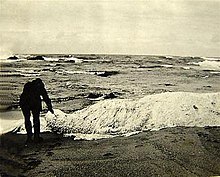Trunko
This article needs additional citations for verification. (July 2015) |
 Artistic depiction of Trunko being mauled by orcas by Bill Asmussen. | |
| Other name(s) | The Margate Monster |
|---|---|
| Country | South Africa |
| Region | Africa |
| Habitat | Water |
Trunko is the nickname for an animal or globster[1] reportedly sighted in Margate, South Africa, on 25 October 1924, according to an article entitled "Fish Like A Polar Bear" published in the 27 December 1924, edition of London's Daily Mail. The animal was reputedly first seen off the coast battling two killer whales, which fought the unusual creature for three hours. It used its tail to attack the whales and reportedly lifted itself out of the water by about 20 feet. One of the witnesses, Hugh Ballance, described the animal as looking like a "giant polar bear" during a final fight.
Description
The creature reputedly washed up on Margate Beach but despite being there for 10 days, no scientist ever investigated the carcass while it was beached, so no reliable description has been published, and until September 2010 it was assumed that no photographs of it had ever been published. Some people who have never been identified were reported to have described the animal as possessing snowy-white fur, an elephantine trunk, a lobster-like tail, and a carcass devoid of blood.
While it was beached, the animal was measured by beach-goers and turned out to be 47 ft (14 m) in length, 10 ft (3 m) wide, and 5 ft (1.5 m) high, with the trunk's length being 5 ft (1.5 m), the trunk's diameter 14 in (36 cm), the tail 10 ft (3 m), and the fur being 8 in (20 cm) long. The trunk was said to be attached directly to the animal's torso, as no head was visible on the carcass. For this feature, the animal was dubbed "Trunko" by British cryptozoologist Karl Shuker in his 1996 book The Unexplained.[2] In the 27 March 1925, edition of the Charleroi Mail, in Charleroi, Pennsylvania, an article entitled "Whales Slain By Hairy Monster" reported that whales there were killed by a strange creature which was washed up on a beach exhausted and fell unconscious, but made its way back into the ocean and swam away after 10 days, never to be seen again.
Explanations

Many suggestions have been made to explain this phenomenon, the most common explanation being that Trunko was the carcass of a large whale, basking shark, or whale shark, whose body's decay made it appear furry and that the orcas were feasting on its corpse.[2] It has also been suggested that Trunko was a sighting of a strange-looking new species of huge whale, unknown pinniped, or sirenian. One of the more skeptical explanations was an albinotic southern elephant seal. It has generally been considered to be a cryptid, part of the field of cryptozoology.
On 6 September 2010 Karl Shuker announced that a hitherto-unknown photograph of Trunko had been discovered by German cryptozoologist Markus Hemmler on the website of the Margate Business Association, and Shuker recognised from this photo that Trunko had been nothing more than a globster, i.e. a massive, tough skin-sac of blubber containing collagen that is sometimes left behind when a whale dies and its skull and skeleton have separated from the skin and sunk to the sea bottom. The photo had been snapped by Johannesburg photographer A. C. Jones, who had visited Trunko's remains while they were beached.[3] Three days later, Shuker revealed that he and Hemmler had independently discovered two more photos of Trunko by Jones that had been published in the August 1925 issue of Wide World Magazine. These close-up photos showed a classic globster, confirming Shuker's identification of Trunko, and clearly revealed its white 'fur' to be exposed connective tissue fibres.[4] It was the sight of two whales some distance out to sea tossing this globsterised mass into the air, a common practice, that had fooled observers on Margate Beach into assuming that it was alive.[5] Perhaps the most surprising aspect of this revelation is that two photos of the Trunko carcass had been published in a mainstream magazine in 1925, yet had somehow been entirely overlooked afterwards by the zoological and cryptozoological community for the next 85 years.[6]
In March 2011, a fourth photograph of Trunko was discovered in the archives of Margate Museum in South Africa by Bianca Baldi.[7]
See also
References
- ^ Newton, Michael (2009). Hidden Animals: A Field Guide to Batsquatch, Chupacabra, and Other Elusive Creatures. ABC-CLIO/Greenwood. pp. 79–80. ISBN 978-0-313-35906-4.
- ^ a b Shuker, Karl P N (1996). The Unexplained. Carlton. p. 95. ISBN 1-85868-186-3.
- ^ Shuker, Karl P.N. (2010). Behold, Trunko!! ShukerNature, 6 September 2010.
- ^ Shuker, Karl P.N. (2010). Trunko - Two More Photographs!! ShukerNature, 9 September 2010.
- ^ Shuker, Karl P.N. (2010). Trunko - Solved After 85 Years! Fortean Times, #268 (November), p. 19
- ^ Shuker, Karl P N (2010). Karl Shuker's Alien Zoo. CFZ Press. pp. 318–319. ISBN 978-1-905723-62-1.
- ^ Shuker, Karl P.N. (2011). Trunko Returns!! A Fourth Photograph Is Discovered! ShukerNature, 10 March 2011.
